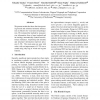Free Online Productivity Tools
i2Speak
i2Symbol
i2OCR
iTex2Img
iWeb2Print
iWeb2Shot
i2Type
iPdf2Split
iPdf2Merge
i2Bopomofo
i2Arabic
i2Style
i2Image
i2PDF
iLatex2Rtf
Sci2ools
103
Voted
EMNLP
2007
2007
Word Sense Disambiguation Incorporating Lexical and Structural Semantic Information
We present results that show that incorporating lexical and structural semantic information is effective for word sense disambiguation. We evaluated the method by using precise information from a large treebank and an ontology automatically created from dictionary sentences. Exploiting rich semantic and structural information improves precision 2–3%. The most gains are seen with verbs, with an improvement of 5.7% over a model using only bag of words and n-gram features.
EMNLP 2007 | Information Improves Precision | Natural Language Processing | Structural Semantic Information | Word Sense Disambiguation |
Related Content
| Added | 29 Oct 2010 |
| Updated | 29 Oct 2010 |
| Type | Conference |
| Year | 2007 |
| Where | EMNLP |
| Authors | Takaaki Tanaka, Francis Bond, Timothy Baldwin, Sanae Fujita, Chikara Hashimoto |
Comments (0)

